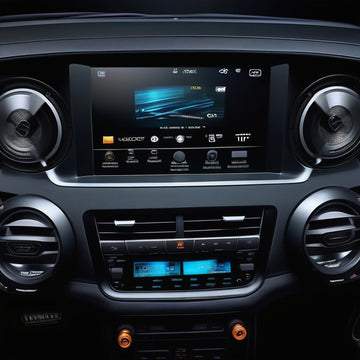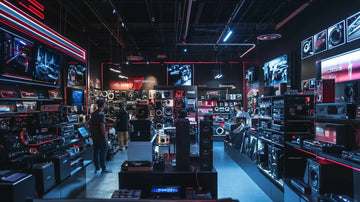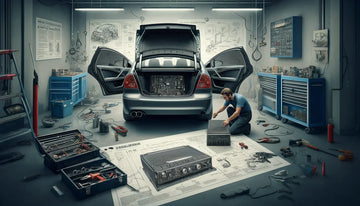Optimize Your Drive: Best Sound Settings for Car Audio
Transform your vehicle into a mobile concert hall with expert-level audio optimization techniques and professional-grade equipment recommendations.
Quick Start: 5-Minute Setup Checklist
Essential Steps:
- 1Set all EQ bands to 0 (flat response)
- 2Adjust amplifier gain to 75% maximum
- 3Set crossover frequencies: 80Hz (sub), 80-3kHz (mid)
- 4Test with familiar music at moderate volume
- 5Fine-tune based on listening preferences
Essential Tools:
- Quality wiring kit
- Multimeter for voltage testing
- Sound deadening materials
- High-quality audio test tracks
- Basic installation tools
Key Highlights
Superior Audio Settings
Achieving exceptional car audio requires precise speaker selection and optimal sound settings.
Component Understanding
Master the basics of amplifiers, speakers, and subwoofers for optimal results.
EQ Settings by Music Genre
| Genre | 32Hz | 64Hz | 125Hz | 250Hz | 500Hz | 1kHz | 2kHz | 4kHz | 8kHz | 16kHz |
|---|---|---|---|---|---|---|---|---|---|---|
| Rock/Metal | +2 | +3 | +1 | -1 | 0 | +1 | +2 | +3 | +2 | +1 |
| Hip-Hop/Rap | +4 | +3 | +2 | 0 | +1 | +2 | 0 | -1 | +1 | +2 |
| Classical | +1 | 0 | 0 | 0 | 0 | 0 | +1 | +2 | +1 | +1 |
| Pop/Top 40 | +2 | +1 | 0 | +1 | +2 | +1 | 0 | +1 | +2 | +1 |
| Jazz/Blues | 0 | +1 | +1 | +2 | +1 | 0 | +1 | +2 | 0 | -1 |
Note: Values are in dB. Start with these settings and adjust based on your speaker system and personal preferences.
Troubleshooting Quick Fixes
🔇 No Bass Response?
🔊 Distorted Sound?
- • Reduce amplifier gain by 25%
- • Check for overdriven head unit (max 75% volume)
- • Verify speaker power handling
- • Inspect wiring for shorts or poor connections
- • Test with different audio source
⚖️ Unbalanced Audio?
- • Adjust left/right balance in head unit
- • Check for mismatched speaker impedances
- • Verify equal power delivery to all channels
- • Inspect for damaged speaker cones
- • Consider time alignment adjustment
🔉 Road Noise Issues?
- • Install sound deadening materials in doors
- • Add dampening to floor and trunk areas
- • Check for rattling panels or trim pieces
- • Consider noise-canceling technology
- • Upgrade to higher sensitivity speakers
Budget-Based System Recommendations
Entry-Level Quality
- • Pioneer/Kenwood coaxial speakers
- • 2-channel amplifier (50W x 2)
- • Basic wiring kit
- • Factory head unit upgrade
- • Minimal sound deadening
Expected Improvement: 200-300% better than factory system
Significant Upgrade
- • Quality component speakers
- • 4-channel amplifier (75W x 4)
- • 10-12" powered subwoofer
- • Premium wiring kit
- • Door sound deadening
Expected Improvement: 400-500% better with rich, full sound
Audiophile-Grade
- • Premium component sets (Dynaudio, etc.)
- • DSP amplifier system
- • Custom subwoofer enclosure
- • Professional installation
- • Complete vehicle sound deadening
Expected Improvement: Concert-hall quality mobile experience
Understanding Car Audio Basics
Before diving into various sound settings and components, understanding car audio basics is crucial. Frequency response refers to the range of frequencies a car audio system can reproduce, with a wider response enabling more immersive listening experiences.
Car audio systems consist of different components including speakers, amplifiers, and equalizers, all working together to deliver high-quality music inside the cabin.
The Components of Car Audio Systems
Car Speakers
Convert electrical signals into sound waves. Available in coaxial and component configurations.
Amplifiers
Increase power of audio signals for better sound quality. Learn amplifier basics.
Types: Monoblock, 2-channel, 4-channel
Equalizers
Allow precise control over specific frequency bands. Advanced DSP options available.
Types: Graphic, Parametric, Digital
How Sound Quality is Affected in Cars
Sound quality in cars faces unique challenges from road noise and cabin acoustics. External sounds interfere with audio clarity, making sound-deadening materials essential for reducing vibrations and improving insulation.
High-quality car stereo systems with features like digital signal processing enhance sound quality and provide immersive listening experiences with digital media.
Brand-Specific Setup Guides
Pioneer Head Unit Optimization
- • Access EQ via Settings > Audio > Graphic EQ
- • Enable "Sound Retriever" for compressed files
- • Set "Auto EQ" based on listening position
- • Adjust "Bass Boost" to +2 for enhanced low-end
- • Configure crossover: High-pass 80Hz for front speakers
JL Audio Amplifier Setup
- • Set input sensitivity using voltmeter method
- • Adjust subsonic filter to 25Hz for ported boxes
- • Enable bass boost conservatively (+3dB max)
- • Set crossover frequency to match speakers
- • Use phase adjustment for subwoofer integration
Dynaudio Component Setup
- • Position tweeters at ear level for optimal imaging
- • Use minimal EQ - Dynaudio speakers are well-balanced
- • Set crossover at 2.5kHz for optimal transition
- • Allow 50+ hours break-in time for full performance
- • Bi-amp if amplifier supports separate channels
DSP Amplifier Configuration
- • Start with manufacturer preset closest to your setup
- • Measure distances for time alignment
- • Set precise crossover points using slopes
- • Apply room correction for cabin acoustics
- • Save multiple presets for different music types
Essential Tips for Enhancing Car Audio Quality
Achieving the best sound quality requires careful consideration of speaker selection, proper placement, and precise equalizer adjustments. Consider speaker size, power handling, and sensitivity when upgrading your system.
Experiment with different equalizer presets or manually adjust settings to suit your listening preferences and music genres. Pay special attention to lower frequencies when adjusting bass settings for optimal sound quality.
Choosing the Right Speakers for Your Car
| Speaker Type | Pros | Cons | Price Range | Best For |
|---|---|---|---|---|
| Coaxial | Easy installation, cost-effective, space-saving | Limited soundstage, compromised imaging | $50-$200 | Budget upgrades, rear speakers |
| Component | Superior imaging, customizable, better separation | Complex installation, higher cost, more space | $100-$800+ | Front stage, audiophile systems |
| Full-Range | Simple setup, decent overall sound | Limited frequency response | $30-$150 | Basic replacements |
The Importance of Proper Speaker Placement
Proper speaker placement is crucial for achieving optimal sound quality. The location and orientation of speakers significantly impact soundstage and imaging, creating a more realistic and immersive listening experience.
Optimal Placement Tips:
- • Position at ear level or slightly above
- • Aim toward listener's seating position
- • Consider distance from listener for timing
- • Angle speakers for proper sound dispersion
- • Avoid obstructions in direct path
Common Mistakes to Avoid:
- • Installing speakers too low in doors
- • Pointing speakers away from listeners
- • Ignoring cabin acoustics and reflections
- • Mismatched left/right positioning
- • Poor tweeter placement in components
Advanced Car Sound Settings Explained
Beyond basic settings, advanced configurations can significantly enhance your car's audio system. The equalizer allows volume adjustment of specific frequency bands, while time alignment and crossover settings refine sound output.
Understanding and utilizing these advanced settings, including volume control and higher frequency management, will help achieve superior audio in your vehicle.
Tuning Your Car's Equalizer for Optimal Sound
Step-by-Step EQ Process
- 1Set all bands to neutral (0dB)
- 2Play familiar reference track
- 3Adjust bass frequencies (20-250Hz)
- 4Fine-tune midrange (250Hz-4kHz)
- 5Adjust treble (4kHz-20kHz)
- 6Make small adjustments and listen
Professional Tips
- • Trust your ears - Measurements don't tell the whole story
- • Less is more - Avoid excessive boosting
- • Consider source material - Different genres need different settings
- • Account for cabin acoustics - Cars have unique challenges
- • Save multiple presets - For different music types
- • Use parametric EQ when available for precision
Balancing Bass, Midrange, and Treble
Bass (20Hz-250Hz)
Foundation of your sound. Controls impact and warmth.
Sub-bass: 20-60Hz - Deep impact
Mid-bass: 60-250Hz - Punch & warmth
Midrange (250Hz-4kHz)
Where most music lives. Vocals and instruments.
Low-mid: 250Hz-1kHz - Body & fullness
Upper-mid: 1-4kHz - Clarity & presence
Treble (4kHz-20kHz)
Adds sparkle and detail to your sound.
Presence: 4-8kHz - Vocal clarity
Brilliance: 8-20kHz - Air & shimmer
The Role of Amplifiers in Car Audio Systems
Amplifiers play a crucial role by increasing power of audio signals, resulting in better sound quality. They provide necessary power to drive speakers and reproduce audio signals accurately.
There's a huge difference between factory stereo power output and a dedicated amplifier. Adding an amplifier can make a huge difference in your car's audio performance.
Selecting the Right Amplifier
| Amplifier Class | Efficiency | Sound Quality | Heat Output | Best Application |
|---|---|---|---|---|
| Class A | Very Low (20-30%) | Excellent | Very High | High-end audio applications |
| Class AB | Good (40-60%) | Very Good | Moderate | Full-range speakers, mids/highs |
| Class D | Excellent (80-90%) | Good | Low | Subwoofers, high-power apps |
Setting Up Your Amplifier for Superior Sound
Installation Checklist
- Use quality wiring harness
- Secure ground connection to metal chassis
- Install appropriate fuse at battery
- Route power wire away from signal cables
- Allow adequate ventilation around amplifier
Tuning Settings
- Set gain using voltmeter method
- Adjust crossover to match speakers
- Configure bass boost conservatively
- Set phase for optimal integration
- Test with various music genres
Integrating Subwoofers into Your Car Audio System
Integrating subwoofers greatly enhances low-end frequencies and provides more immersive sound experiences. These specialized speakers reproduce low bass frequencies and add depth to music genres relying on low-end frequencies.
Poor subwoofer performance can result in horrible sound experiences, especially in classical music's low mids. Consider factors like size, power handling, and enclosure design for optimal bass performance.
Choosing the Best Subwoofer for Your Needs
8-10 Inch Subwoofers
Compact size, tight bass response
- • Best for limited space installations
- • Quick, punchy bass response
- • Power requirements: 200-400W RMS
- • Ideal for rock, jazz, vocals
12 Inch Subwoofers
Perfect balance of size and performance
MOST POPULAR- • Excellent all-around performance
- • Deep, impactful bass
- • Power requirements: 300-600W RMS
- • Great for all music genres
15+ Inch Subwoofers
Maximum output and extension
- • Deepest bass extension
- • Highest output levels
- • Power requirements: 500W+ RMS
- • Best for EDM, hip-hop, movies
Installation Tips for Maximum Bass Performance
Enclosure Selection
Installation Best Practices
- Location: Trunk/cargo area for optimal acoustics
- Wiring: Use high-quality wiring kit
- Gain: Set to 75% maximum, adjust by ear
- Damping: Add sound deadening to reduce vibrations
- Phase: Adjust for integration with main speakers
Utilizing Sound-Deadening Materials
Sound-deadening materials significantly improve overall sound quality by reducing vibrations and minimizing road noise. Materials like Dynamat absorb vibrations and prevent interference with audio playback.
Focus installation on areas prone to vibrations such as doors, trunk, and floor. By minimizing vibrations and road noise, sound-deadening materials enhance clarity and depth of audio in your car.
Benefits of Sound Deadening in Cars
Noise Reduction Benefits
- • Reduced road noise: Quieter cabin environment
- • Improved audio clarity: Enhanced detail and separation
- • Enhanced bass performance: Tighter, more controlled low frequencies
- • Reduced vibrations: Eliminates rattles and unwanted resonance
Performance Improvements
- • Better sound isolation: Less external interference
- • Increased system efficiency: Speakers work less to overcome noise
- • Enhanced listening comfort: Reduced fatigue during long drives
- • Professional sound quality: Studio-like listening environment
How to Apply Sound Deadening for Optimal Results
Priority Areas
- Door panels (high priority)
- Floor areas
- Trunk/cargo area
- Roof (if budget allows)
Installation Tips
- • Clean surfaces thoroughly before application
- • Cut materials to appropriate size and shape
- • Apply with firm pressure for good adhesion
- • Layer materials for maximum effectiveness
Coverage Guidelines
- • Doors: 25-50% coverage minimum
- • Floor: Focus on large flat areas
- • Trunk: Rear deck and sidewalls
- • Budget: $100-300 for basic treatment
Pro Tip: Start with door treatment for the biggest impact, then expand to other areas as budget allows. Quality materials make a significant difference in performance and longevity.
The Impact of High-Quality Audio Files
The quality of audio files significantly impacts overall sound quality in your car. High-quality files like lossless formats (FLAC) or high-bitrate MP3s preserve more original sound information and result in better reproduction.
When sourcing music for your audio system, aim for high-quality sources like CDs or lossless downloads. Using USB cable and Apple CarPlay with aftermarket stereos utilizes advanced digital-to-analog converters for superior sound quality.
Differences Between Audio File Formats
| Format | Quality | File Size | Compression | Best Use |
|---|---|---|---|---|
| FLAC | Lossless - Perfect | Large (30-40MB/song) | None | Critical listening, audiophile systems |
| WAV/AIFF | Lossless - Perfect | Very Large (50MB+/song) | None | Studio work, archival |
| MP3 320kbps | Very Good | Medium (8-10MB/song) | Lossy | General listening, good balance |
| AAC 256kbps | Good | Small (6-8MB/song) | Lossy | iTunes, Apple devices |
| Spotify/Streaming | Variable | N/A (Streaming) | Varies | Convenience, discovery |
How to Source High-Quality Music Files
Best Quality Sources
- Purchase and rip CDs to FLAC/ALAC
- High-resolution download stores (HDtracks, Qobuz)
- Bandcamp lossless downloads
- Tidal HiFi lossless streaming
Streaming Considerations
- Use highest quality settings available
- Download for offline use when possible
- Consider data usage and connection quality
- Use wired connection for best quality
Professional Car Audio Tuning Demonstration
Watch this comprehensive guide to tuning your car stereo's equalizer for optimal sound quality without DSP equipment.
Conclusion
Achieving superior audio in your car requires understanding the basics and implementing essential optimization techniques. Choose the right components like speakers and amplifiers, optimize sound settings including equalizer tuning and speaker placement.
Integrating subwoofers and sound-deadening materials further enhances the audio experience. By following these steps and utilizing high-quality audio files, you can create a premium sound system that elevates your driving experience to a new level of auditory pleasure.
Frequently Asked Questions
What are the best settings for car audio equalizers?
The best EQ settings vary by personal preference, music types, and car acoustics. Start with our genre-specific recommendations above, then experiment with different settings to find the right balance of bass, midrange, and treble frequencies for your listening experience.
Is it worth upgrading factory car speakers?
Absolutely! Upgrading factory speakers can significantly improve sound quality and enhance your overall listening experience. High-quality aftermarket speakers offer better performance, clarity, and more detailed sound reproduction, making it a worthwhile audio upgrade.
How do I reduce noise and vibrations in my car audio system?
Reducing noise and vibrations is achieved by using sound-deadening materials. These materials absorb vibrations and minimize external noise, resulting in a quieter and more enjoyable listening experience.
What is the ideal way to position speakers for the best sound quality?
Position speakers at ear level or slightly above, aiming them toward the listener's seating position. This creates a more realistic and immersive soundstage, enhancing the overall listening experience in your car. Consider the distance and angle for proper sound dispersion.
Should I choose sealed or ported subwoofer enclosures?
Sealed enclosures provide tight, accurate bass ideal for all music genres, while ported enclosures offer louder, more efficient output but require more space. Learn more in our detailed comparison guide.





